Egyptian authorities announced the discovery of an ancient tomb in Luxor dating back around 3,500 years that archaeologists believe holds the remains of an 18th dynasty royal.
The tomb was unearthed on the west bank of the River Nile, where the famous Valley of the Queens and Valley of the Kings lie, by a team of Egyptian and British researchers.
“The 18th dynasty, part of the period of Egyptian history known as the New Kingdom, ended in 1292 BC and is considered among the most prosperous years of Ancient Egypt,” said Mostafa Waziri, head of Egypt’s Supreme Council of Antiquities.
Piers Litherland of the University of Cambridge, head of the British research mission, said the tomb could be of a royal wife or princess of Thutmosid lineage.

The Interior of the Royal Tomb in Luxor
Egyptian archaeologist Mohsen Kamel said the tomb’s interior was “in poor condition.” Parts of it including inscriptions were “destroyed in ancient floods which filled the burial chambers with sand and limestone sediment,” Kamel added, according to the antiquities board’s statement.
A boost for Egypt’s tourism industry
Egypt has unveiled several major archaeological discoveries in recent years, most notably in the Saqqara necropolis south of the capital Cairo.
Critics say the flurry of excavations has prioritised finds shown to grab media attention over hard academic research.
But the discoveries have been a key component of Egypt’s attempts to revive its vital tourism industry, the crowning jewel of which is the long-delayed inauguration of the Grand Egyptian Museum at the foot of the pyramids.
Egypt’s tourism industry accounts for 10 percent of GDP and some two million jobs, according to official figures, but has been hammered by political unrest and the COVID-19 pandemic.
The discovery of the Royal Tomb in Luxor is expected to boost the country’s tourism industry, which is in dire need of a boost.







